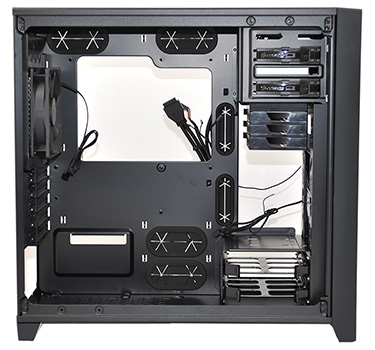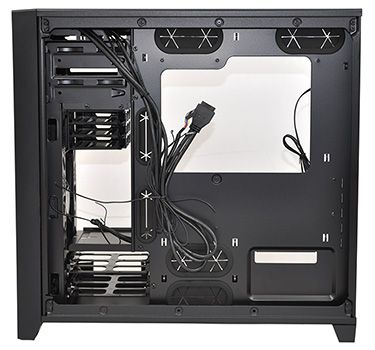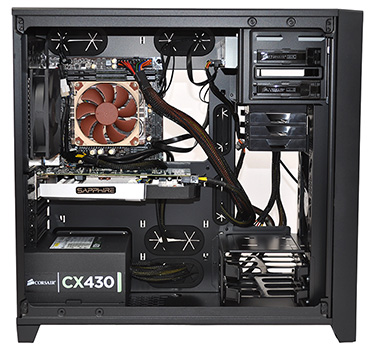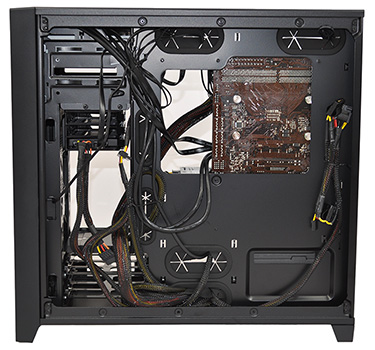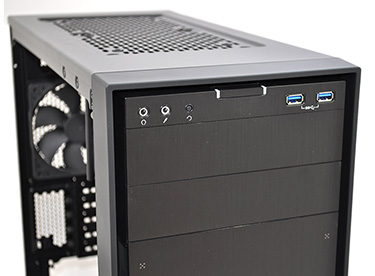Built For Big Things
As you've no doubt realised, we're itching to see Corsair create something that can truly be described as small-form-factor. The Obsidian Series 350D isn't it, but on the flip side, if you're looking for a chassis specifically for a high-performance micro-ATX build, this is an enclosure that will no doubt serve you well.
On the inside, the 350D has many of the usual Corsair hallmarks. The all-black interior feels spacious throughout, with rubber-grommeted cable-routing holes, a huge cutout in the motherboard tray for CPU cooler installation, and some of the little touches that help simplify the build process, such as pre-installed motherboard standoffs and a central mounting nub.
Chassis storage, meanwhile, is undergoing a transitional phase, with various manufacturers moving away from numerous 3.5in bays in favour of SSD-sized 2.5in mounts. For the Obsidian 350D, Corsair has just two of the aforementioned 3.5in drive trays - which, sadly, are still of the basic plastic variety - and offers greater 2.5in support with three bays attached to the underside of the optical-drive cage.
The compact 2.5in trays are also featured in the Carbide Series Air 540, and they work well, with SSDs slotting in securely and with ease. These trays are stackable, so we suspect Corsair will make additional units available as an optional extra, and it's worth noting that all of the 350D's drive bays - be they 2.5in, 3.5in or 5.25in - are entirely tool-free.
What's handy is that the out-the-box storage configuration leaves room for large graphics cards that measure up-to 380mm in length and a clear path for front-to-back airflow. As standard, Corsair includes a 140mm front intake and a 120mm rear exhaust, with the chassis supporting up to five fans in total; two up front, two up top and one at the back. High-performance users may bemoan the fact that there's no mounting point on the side panel, but there's a good amount of liquid-cooling potential; all five available mounts offer radiator support.
Removing the storage bays creates room for a 240mm radiator up front (though you'd then need to be imaginative when installing a hard drive), there's plenty of space for a 240mm radiator up top, and a 120mm radiator can be added to the rear. Better still, if you're also willing to forego the upper optical-drive bay, there is support for a top-mounted 280mm radiator; Corsair's own Hydro Series H110 springs to mind.
HEXUS' new mini-ITX test platform consists of an ASRock FM2A85X-ITX board, an AMD A10-6700 APU, 16GB of Adata XPG DDR3 memory and a low-profile Noctua NH-L9a cooler, and the Obsidian Series 350D makes the hardware look absolutely tiny. So much so that we felt obliged to add a discrete graphics card - in this case a Sapphire Radeon HD 7770 Vapor-X.
Building into the chassis really is a doddle thanks to ample room, good cable-routing opportunities and tool-free drive bays. There's also a decent amount of room behind the motherboard tray (roughly 2cm), and the hinged side panels make it easy to squeeze in excess cabling without having to struggle.
Trouble is, the size of the chassis does dictate the type of build required. Our mid-range mini-ITX components are well-suited to small-form-factor PCs, but the hardware just isn't befitting the Obsidian Series 350D. This thing really is crying out for a micro-ATX board, a couple of graphics cards and at least a radiator or two.
Plenty of cable tie-down loops are available to help keep things tidy, although it's a shame the cable clamps available to the 900D haven't been carried over. Dust filters, meanwhile, are present beneath the power supply and inside the push-to-release front face; making both accessible and easy to clean.
Easy to work with and able to house plenty of high-end hardware - this should be the micro-ATX chassis of choice for enthusiasts. Yet, we find ourselves wondering if Corsair's dedication to liquid-cooling has made the 350D unnecessarily large. Despite being the company's smallest chassis to date, the Obsidian Series 350D just isn't as compact as we'd imagined.
Corsair has done well to keep the price below the £100 mark - microATX and miniITX chassis need price tags befitting their size - but in trimming the 350D down to a certain size, the chassis has arguably lost some of that premium Obsidian feel. There are no quick-release side panels, no hot-swappable drive bays, no soundproofing, no fan controllers and the minimalist front I/O panel sports only two USB 3.0 ports. Many of the features that made other Obsidian Series shine haven't made the cut, and unfortunately Corsair hasn't spruced up the 900D-like optical-bay covers, either; install a drive and the chassis' frontal appearance is ruined.
Perhaps we've been spoiled by the recent Carbide Series Air 540, which while considerably thicker, stands at almost the same height and depth and yet is considerably more interesting to work with.






